
Advanced Java Hikvision SDK Secondary Development Technical Guide
Introduction:
With the development of technology and the continuous expansion of application scenarios, video surveillance systems have gradually become an integral part of modern society. In the market, Hikvision's products have always been in a leading position, providing a series of high-quality video surveillance solutions. However, for some special needs, relying solely on native functions may not be able to meet them, which requires secondary development of Hikvision SDK. This article will focus on the advanced Java Hikvision SDK secondary development technology and give corresponding code examples.
1. SDK download and installation
- Go to Hikvision official website and find the SDK download page. According to your needs, select the corresponding SDK version and click to download.
- After the download is completed, unzip the file to the local directory.
- Import SDK into Java development tools.
2. SDK environment configuration
- Create a new Java project in the development tool.
- Add the jar package in the SDK to the project's dependencies.
- Configure JVM parameters and add the corresponding dynamic link library path.
3. SDK Initialization and Login
Before secondary development, we need to initialize and log in to the SDK to obtain the corresponding operating permissions.
import com.sun.jna.NativeLong;
import com.sun.jna.Pointer;
import com.sun.jna.ptr.IntByReference;
import com.sun.jna.ptr.PointerByReference;
import com.hikvision.netsdk.HCNetSDK;
public class SDKDemo {
private static HCNetSDK hCNetSDK = HCNetSDK.INSTANCE;
public static void main(String[] args) {
// SDK初始化
boolean initSuc = hCNetSDK.NET_DVR_Init();
if (initSuc != true) {
System.out.println("SDK初始化失败!");
return;
}
// 登录
HCNetSDK.NET_DVR_DEVICEINFO_V30 deviceInfo = new HCNetSDK.NET_DVR_DEVICEINFO_V30();
NativeLong lUserId = hCNetSDK.NET_DVR_Login_V30("192.168.1.100", (short) 8000,
"admin", "password", deviceInfo);
if (lUserId.longValue() < 0) {
System.out.println("登录失败:" + hCNetSDK.NET_DVR_GetLastError());
return;
}
// 登出
boolean logoutSuc = hCNetSDK.NET_DVR_Logout(lUserId);
if (logoutSuc != true) {
System.out.println("登出失败:" + hCNetSDK.NET_DVR_GetLastError());
return;
}
// SDK反初始化
boolean cleanupSuc = hCNetSDK.NET_DVR_Cleanup();
if (cleanupSuc != true) {
System.out.println("SDK反初始化失败!");
return;
}
}
}4. Video Preview
This section will introduce how to perform video preview operations and show how to set up a callback function to obtain video data in real time.
import com.sun.jna.CallbackThreadInitializer;
import com.sun.jna.NativeLong;
import com.sun.jna.Pointer;
import com.sun.jna.ptr.IntByReference;
import com.sun.jna.ptr.PointerByReference;
import com.hikvision.netsdk.*;
public class SDKDemo {
private static HCNetSDK hCNetSDK = HCNetSDK.INSTANCE;
public static void main(String[] args) {
// SDK初始化...
// 登录...
// 实时预览
NativeLong lRealPlayHandle = hCNetSDK.NET_DVR_RealPlay_V30(lUserId, deviceInfo.byStartChan, null, null, true);
if (lRealPlayHandle.longValue() < 0) {
System.out.println("实时预览失败:" + hCNetSDK.NET_DVR_GetLastError());
return;
}
// 设置预览回调函数
HCNetSDK.FRealDataCallBack fRealDataCallBack = new HCNetSDK.FRealDataCallBack() {
public void invoke(NativeLong lRealHandle, int dwDataType, Pointer pBuffer, int dwBufSize, Pointer pUser) {
if (dwDataType == HCNetSDK.NET_DVR_SYSHEAD) {
// 获取系统头数据
System.out.println("收到系统头数据");
} else if (dwDataType == HCNetSDK.NET_DVR_STREAMDATA) {
// 获取流数据
byte[] data = pBuffer.getByteArray(0, dwBufSize);
System.out.println("接收到视频数据:" + data.length);
}
}
};
boolean setCallbackSuc = hCNetSDK.NET_DVR_SetRealDataCallBack(lRealPlayHandle, fRealDataCallBack, null);
if (setCallbackSuc != true) {
System.out.println("设置预览回调函数失败:" + hCNetSDK.NET_DVR_GetLastError());
return;
}
// 停止预览
boolean stopPlaySuc = hCNetSDK.NET_DVR_StopRealPlay(lRealPlayHandle);
if (stopPlaySuc != true) {
System.out.println("停止预览失败:" + hCNetSDK.NET_DVR_GetLastError());
return;
}
// 登出...
// SDK反初始化...
}
}Conclusion:
The above is an introduction to the advanced Java Hikvision SDK secondary development technology. Through the implementation of SDK initialization, login, video preview and other operations, more personalized functional requirements can be realized. I hope this article will be helpful to developers who want to carry out secondary development of Hikvision SDK.
The above is the detailed content of Advanced Java Hikvision SDK Secondary Development Technical Guide. For more information, please follow other related articles on the PHP Chinese website!
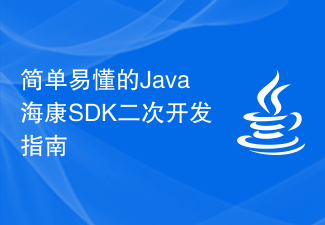 简单易懂的Java海康SDK二次开发指南Sep 06, 2023 pm 02:01 PM
简单易懂的Java海康SDK二次开发指南Sep 06, 2023 pm 02:01 PM简单易懂的Java海康SDK二次开发指南引言:随着摄像监控技术的发展,海康威视已成为全球领先的安防解决方案供应商之一,其提供的SDK(软件开发工具包)为开发人员提供了丰富的功能和接口,用于二次开发和定制化开发。本文将介绍如何使用Java语言进行海康SDK的二次开发,并提供一些代码示例,以帮助读者更好地理解和应用。一、环境准备首先,在进行海康SDK二次开发之前
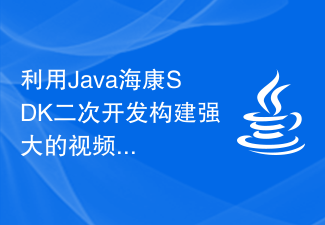 利用Java海康SDK二次开发构建强大的视频监控系统Sep 06, 2023 pm 12:37 PM
利用Java海康SDK二次开发构建强大的视频监控系统Sep 06, 2023 pm 12:37 PM利用Java海康SDK二次开发构建强大的视频监控系统摘要:本文将介绍如何利用Java海康SDK进行二次开发,构建一个强大的视频监控系统。通过海康SDK提供的丰富接口和功能,我们可以轻松实现视频录像、实时预览、远程控制等功能,并且加入自定义的业务逻辑。本文将详细介绍如何使用Java海康SDK进行二次开发,并提供一些示例代码以帮助读者更好地理解。第一部分:环境准
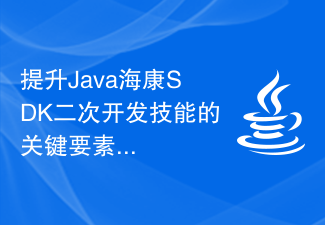 提升Java海康SDK二次开发技能的关键要素Sep 06, 2023 pm 01:42 PM
提升Java海康SDK二次开发技能的关键要素Sep 06, 2023 pm 01:42 PM提升Java海康SDK二次开发技能的关键要素摘要:随着物联网的快速发展,视频监控系统在安防领域的应用越来越广泛。而作为视频监控系统中最重要的组成部分,海康威视(Hikvision)的SDK在二次开发过程中扮演着重要的角色。本文将介绍海康SDK的基本使用方法,并提供一些关键要素和代码示例,以帮助读者提升Java海康SDK二次开发技能。一、了解海康SDK的基本概
 Java海康SDK二次开发中实现高度可定制化的解决方案Sep 06, 2023 am 10:12 AM
Java海康SDK二次开发中实现高度可定制化的解决方案Sep 06, 2023 am 10:12 AMJava海康SDK二次开发中实现高度可定制化的解决方案摘要:在现代监控系统中,海康SDK是非常常用的开发框架之一。本文将介绍如何基于Java语言和海康SDK进行二次开发,从而实现高度可定制化的解决方案。同时,文章还会提供一些代码示例来帮助读者更好地理解实现过程。一、介绍随着互联网和物联网的快速发展,监控系统的应用范围越来越广泛。而海康SDK作为目前市场上最具
 Java海康SDK二次开发中常见问题的解决方法Sep 06, 2023 pm 01:07 PM
Java海康SDK二次开发中常见问题的解决方法Sep 06, 2023 pm 01:07 PMJava海康SDK二次开发中常见问题的解决方法一、引言随着物联网技术的发展,视频监控系统已经成为了现代社会中重要的安全保障手段。而在视频监控系统的开发过程中,海康SDK往往被广泛应用。然而,在使用过程中,我们经常会遇到一些常见的问题,本文将逐步为您介绍并提供解决方法。二、问题一:SDK导入问题在二次开发中,首要的问题就是如何正确地导入海康SDK。以下是一些常
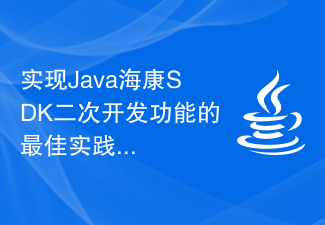 实现Java海康SDK二次开发功能的最佳实践Sep 06, 2023 am 10:19 AM
实现Java海康SDK二次开发功能的最佳实践Sep 06, 2023 am 10:19 AM实现Java海康SDK二次开发功能的最佳实践导语:随着物联网技术的发展,视频监控系统的应用越来越广泛。海康威视是全球领先的安防产品和解决方案提供商,其海康SDK提供了丰富的功能和接口,方便开发者进行二次开发。本文将介绍如何利用Java语言实现海康SDK的二次开发功能,并提供相应的代码示例。一、环境准备在开始之前,我们需要准备以下环境:JDK1.8及以上版本
 如何利用Java海康SDK进行自定义功能的二次开发Sep 06, 2023 am 09:28 AM
如何利用Java海康SDK进行自定义功能的二次开发Sep 06, 2023 am 09:28 AM如何利用Java海康SDK进行自定义功能的二次开发导语:随着科技的不断进步,监控设备在我们生活中扮演着越来越重要的角色。而海康威视作为国内监控设备的领导者之一,其SDK提供了强大的开发平台,使开发者可以根据自己的需求进行二次开发。本文将介绍如何利用Java海康SDK进行自定义功能的二次开发,旨在帮助开发者更好地利用海康SDK进行项目开发。一、Hikvisio
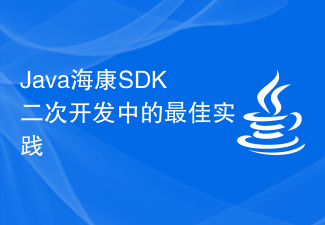 Java海康SDK二次开发中的最佳实践Sep 06, 2023 am 09:04 AM
Java海康SDK二次开发中的最佳实践Sep 06, 2023 am 09:04 AMJava海康SDK二次开发中的最佳实践摘要:随着现代监控技术的广泛应用,海康威视提供的SDK(软件开发工具包)成为了众多开发人员的首选。本文将介绍在Java海康SDK二次开发中的最佳实践,并提供一些代码示例。连接设备使用海康SDK之前,首先需要连接要操作的设备。下面是一个连接设备的示例代码:importcom.sun.jna.NativeLong;imp


Hot AI Tools

Undresser.AI Undress
AI-powered app for creating realistic nude photos

AI Clothes Remover
Online AI tool for removing clothes from photos.

Undress AI Tool
Undress images for free

Clothoff.io
AI clothes remover

AI Hentai Generator
Generate AI Hentai for free.

Hot Article

Hot Tools

ZendStudio 13.5.1 Mac
Powerful PHP integrated development environment

Safe Exam Browser
Safe Exam Browser is a secure browser environment for taking online exams securely. This software turns any computer into a secure workstation. It controls access to any utility and prevents students from using unauthorized resources.

DVWA
Damn Vulnerable Web App (DVWA) is a PHP/MySQL web application that is very vulnerable. Its main goals are to be an aid for security professionals to test their skills and tools in a legal environment, to help web developers better understand the process of securing web applications, and to help teachers/students teach/learn in a classroom environment Web application security. The goal of DVWA is to practice some of the most common web vulnerabilities through a simple and straightforward interface, with varying degrees of difficulty. Please note that this software

SublimeText3 English version
Recommended: Win version, supports code prompts!

VSCode Windows 64-bit Download
A free and powerful IDE editor launched by Microsoft






